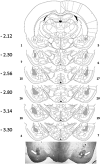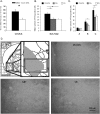Post-retrieval disruption of a cocaine conditioned place preference by systemic and intrabasolateral amygdala beta2- and alpha1-adrenergic antagonists
- PMID: 19940038
- PMCID: PMC2788211
- DOI: 10.1101/lm.1648509
Post-retrieval disruption of a cocaine conditioned place preference by systemic and intrabasolateral amygdala beta2- and alpha1-adrenergic antagonists
Abstract
Previous work has demonstrated post-retrieval impairment in associative learning paradigms, including those mediated by drugs of abuse, using nonspecific beta-adrenergic receptor (beta-AR) antagonists. Remarkably little is known about the role of the specific beta-AR subtypes, or other adrenergic receptors, in these effects. The current study examined the effects of beta(1) and beta(2), as well as alpha(1)-adrenergic receptor antagonism following retrieval of a cocaine conditioned place preference (CPP). We found that rats administered the beta(2) antagonist ICI 118,551 (8 mg/kg intraperitoneal [IP]) or the alpha(1) antagonist prazosin (1 mg/kg IP) following a drug-free test for CPP showed attenuated preference during a subsequent test, while the beta(1) antagonist betaxolol (5 or 10 mg/kg IP) and a lower dose of prazosin (0.3 mg/kg IP) had no effect. Furthermore, post-test microinfusion of ICI 118,551 (6 nmol/side) or prazosin (0.5 nmol/side) into the basolateral amygdala (BLA) also impaired a subsequent preference. Systemic or intra-BLA ICI 118,551 or prazosin administered to rats in their home cages, in the absence of a preference test, had no effect on CPP 24 h later. ICI 118,551 also attenuated the FOS response in the BLA induced by the CPP test. These results are the first to demonstrate a role for alpha(1)- and beta(2)-specific adrenergic mechanisms in post-retrieval memory processes. These systemic and site-specific injections, as well as the FOS immunohistochemical analyses, implicate the importance of specific noradrenergic signaling mechanisms within the BLA in post-retrieval plasticity.
Figures











References
-
- Abrari K, Rashidy-Pour A, Semnanian S, Fathollahi Y. Administration of corticosterone after memory reactivation disrupts subsequent retrieval of a contextual conditioned fear memory: Dependence upon training intensity. Neurobiol Learn Mem. 2008;89:178–184. - PubMed
-
- Berlau DJ, McGaugh JL. Enhancement of extinction memory consolidation: The role of the noradrenergic and GABAergic systems within the basolateral amygdala. Neurobiol Learn Mem. 2006;86:123–132. - PubMed
-
- Bernardi RE, Lattal KM, Berger SP. Postretrieval propranolol disrupts a cocaine conditioned place preference. Neuroreport. 2006;17:1443–1447. - PubMed
-
- Bevins RA. The reference-dose place conditioning procedure yields a graded dose-effect function. Int J Comp Psychol. 2005;18:101–111.
-
- Bormann NM, Cunningham CL. The effects of naloxone on expression and acquisition of ethanol place conditioning in rats. Pharmacol Biochem Behav. 1997;58:975–982. - PubMed
Publication types
MeSH terms
Substances
Grants and funding
LinkOut - more resources
Full Text Sources
Research Materials
